NCERT Class 7 Science Chapter 12 Reproduction in Plants Solutions to each chapter is provided in the list so that you can easily browse through different chapters NCERT Class 7 Science Chapter 12 Reproduction in Plants and select need one. NCERT Class 7 Science Chapter 12 Reproduction in Plants Question Answers Download PDF. NCERT Class 7 Science Solutions.
NCERT Class 7 Science Chapter 12 Reproduction in Plants
Also, you can read the NCERT book online in these sections Solutions by Expert Teachers as per Central Board of Secondary Education (CBSE) Book guidelines. CBSE Class 7 Science Solutions are part of All Subject Solutions. Here we have given NCERT Class 7 Science Chapter 12 Reproduction in Plants and Textbook for All Chapters, You can practice these here.
Reproduction in Plants
Chapter: 12
NCERT TEXT BOOK EXERCISES
Q. 1. Fill in the blanks:
(a) Production of new individuals from the vegetative part of parent is called ____________.
Ans: Vegetative reproduction.
(b) A flower may have either male or female reproductive parts. Such a flower is called ____________.
Ans: Bisexual flower.
(c) The transfer of pollen grains from the anther to the stigma of the same or of another flower of the same kind is known as ____________.
Ans: Pollination.
(d) The fusion of male and female gametes is termed as ___________.
Ans: Fertilization.
(e) Seed dispersal takes place by means of __________, __________ and __________.
Ans: Wind, water, insects.
Q. 2. Describe the different methods of asexual reproduction. Give examples. Ans to Binary Fission: During this process, two daughter organisms of equal sizes are formed from one parent by the division of the parent body. This is the most common method of reproduction in algae, fungi and bacteria.

Fig. 12. 31. Binary fission in bacteria.
(ii) Budding: In this type of reproduction, a small outgrowth appears on the body of the organisms. This outgrowth is called a bud. The buds grow and finally detach from the parent body and begin to live as independent organisms. (see Fig. 12.32)
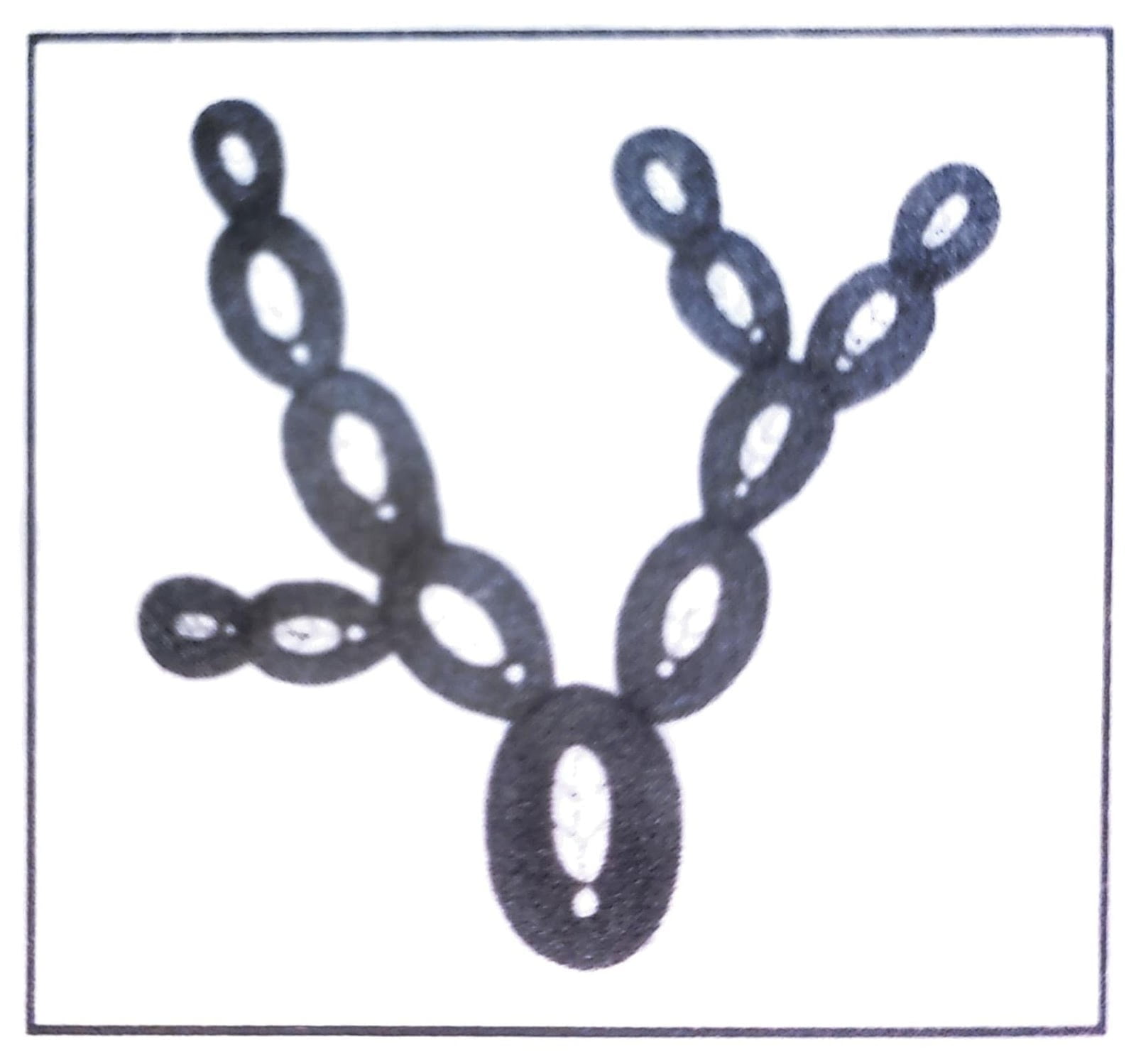
Fig. 12.32. Budding in yeast.
(iii) Spore formation: Some lower plants such as ferns, mosses, lichens and fungi reproduce through spore formation under unfavorable conditions. Spores are tiny, microscopic bodies, which are covered by hard protective coats. The protective coats unable them to tide over adverse environmental conditions. When favourable conditions return, each spore gives rise to a new individual. (see Fig. 12.33)
(iv) Fragmentation: This takes place in algae like spirogyra. The filament of the alga breaks into two or more pieces called fragments and the process is known as fragmentation. Each fragment then grows into a new plant.
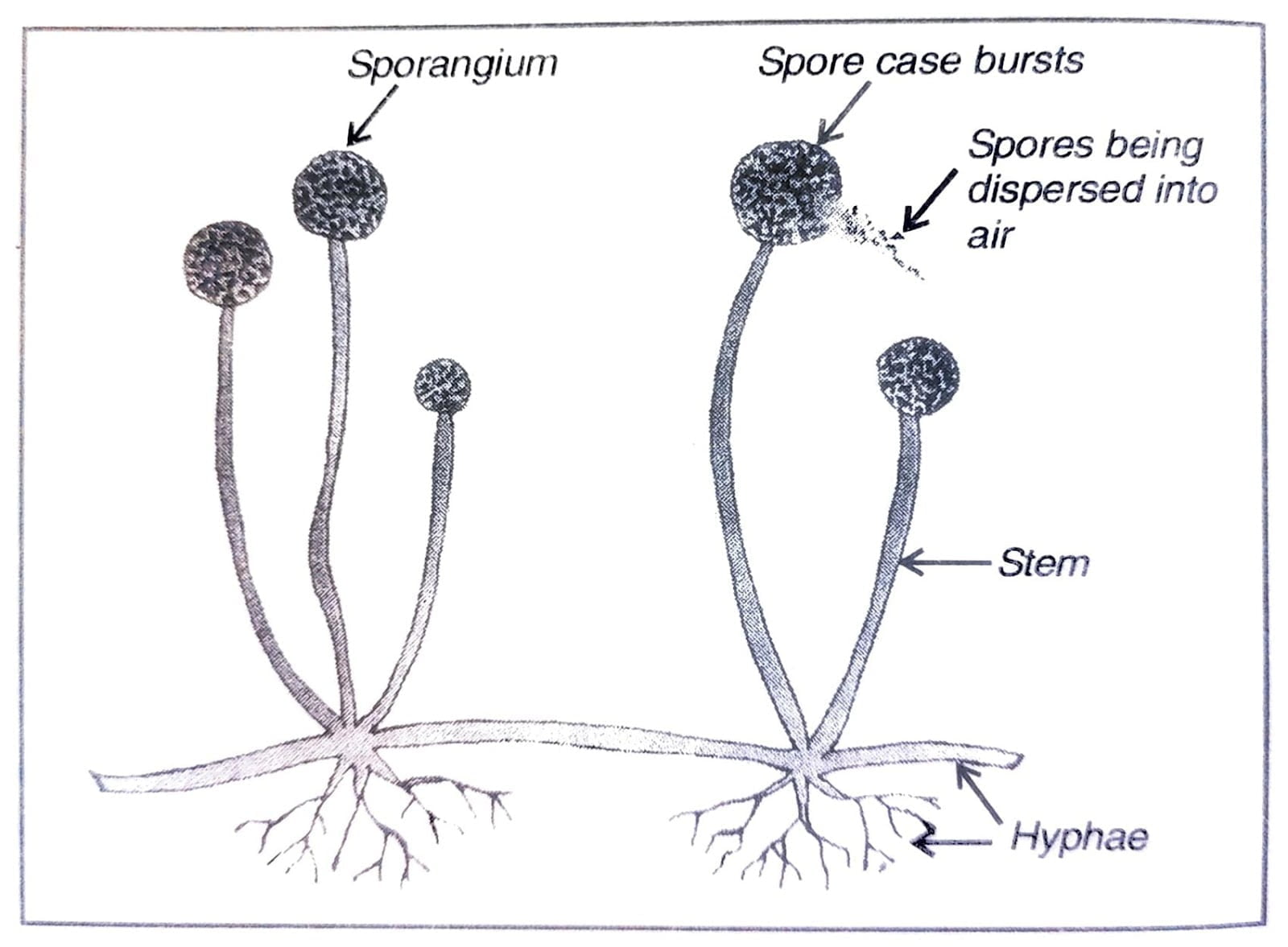
Fig. 12.33. Spore formation in fungus
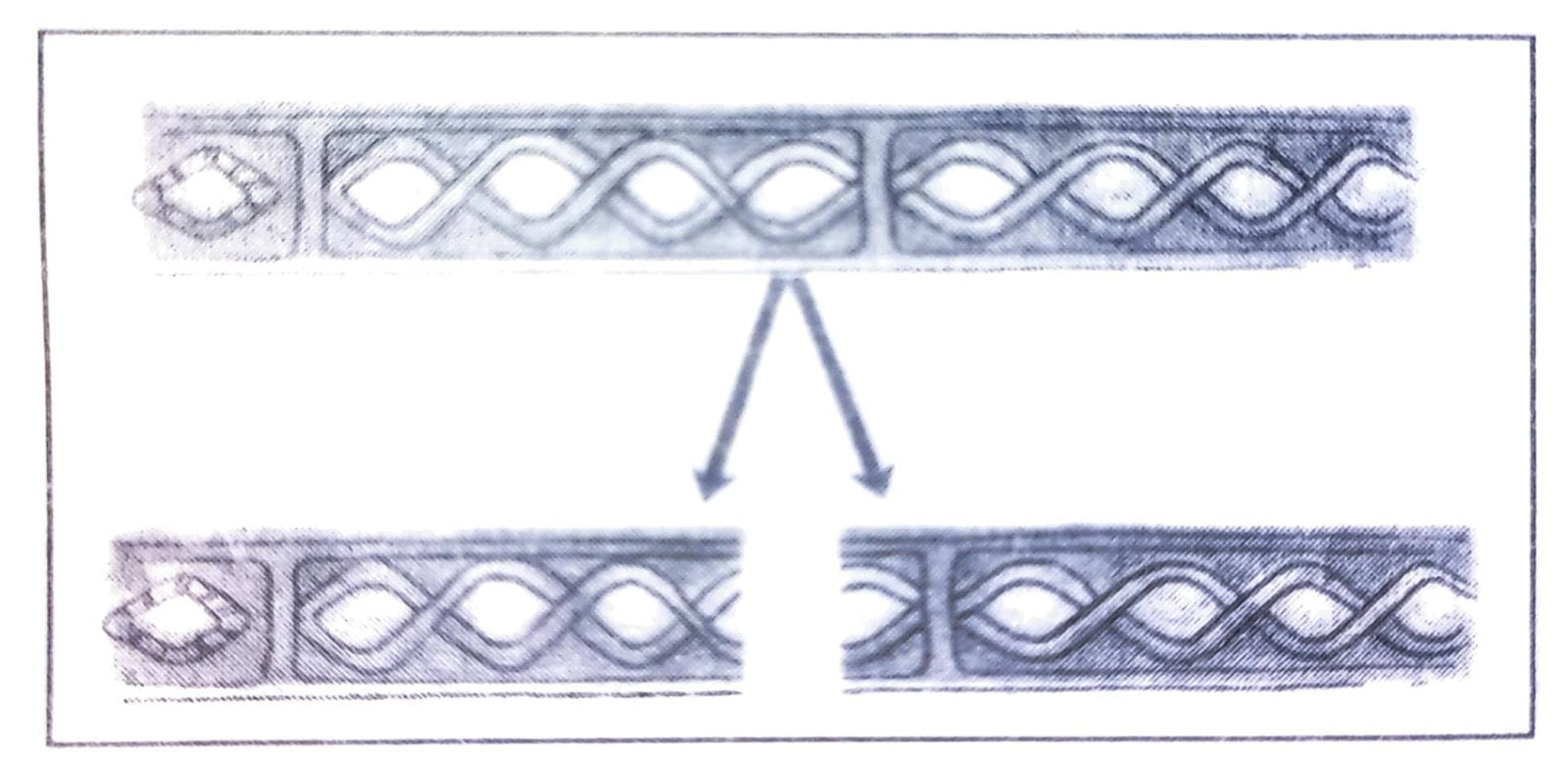
Fig. 12.34. Fragmentation in spirogyra.
Q. 3. Explain what you understand by sexual reproduction.
Ans: Sexual reproduction means involvement of two parents in the process of reproduction. It is found mainly in higher plants. Male gamete and female gamete fuse to form a zygote. These zygotes develop into individuals which are not identical. Offspring inherit the characteristics of both the parents. In sexual reproduction bech parents survive after the process of reproduction.
Q.4. State the main differences between asexual and sexual reproduction.
Ans:
| Asexual Reproduction | Sexual Reproduction |
| 1. Only one parent plant is involved. | 1. Both male and female parents are involved. |
| 2. Reproductive parts are not present. | 2. Fully developed reproductive parts are present. |
| 3. Processes like gamete formation orfertilization is not seen. | 3. Fertilization of gametes give rise to zygote. |
| 4. Characteristics of only one parent is inherited. | 4. Characteristics of both parents are inherited. |
Q. 5. Sketch the reproductive parts of a flower.
Ans:
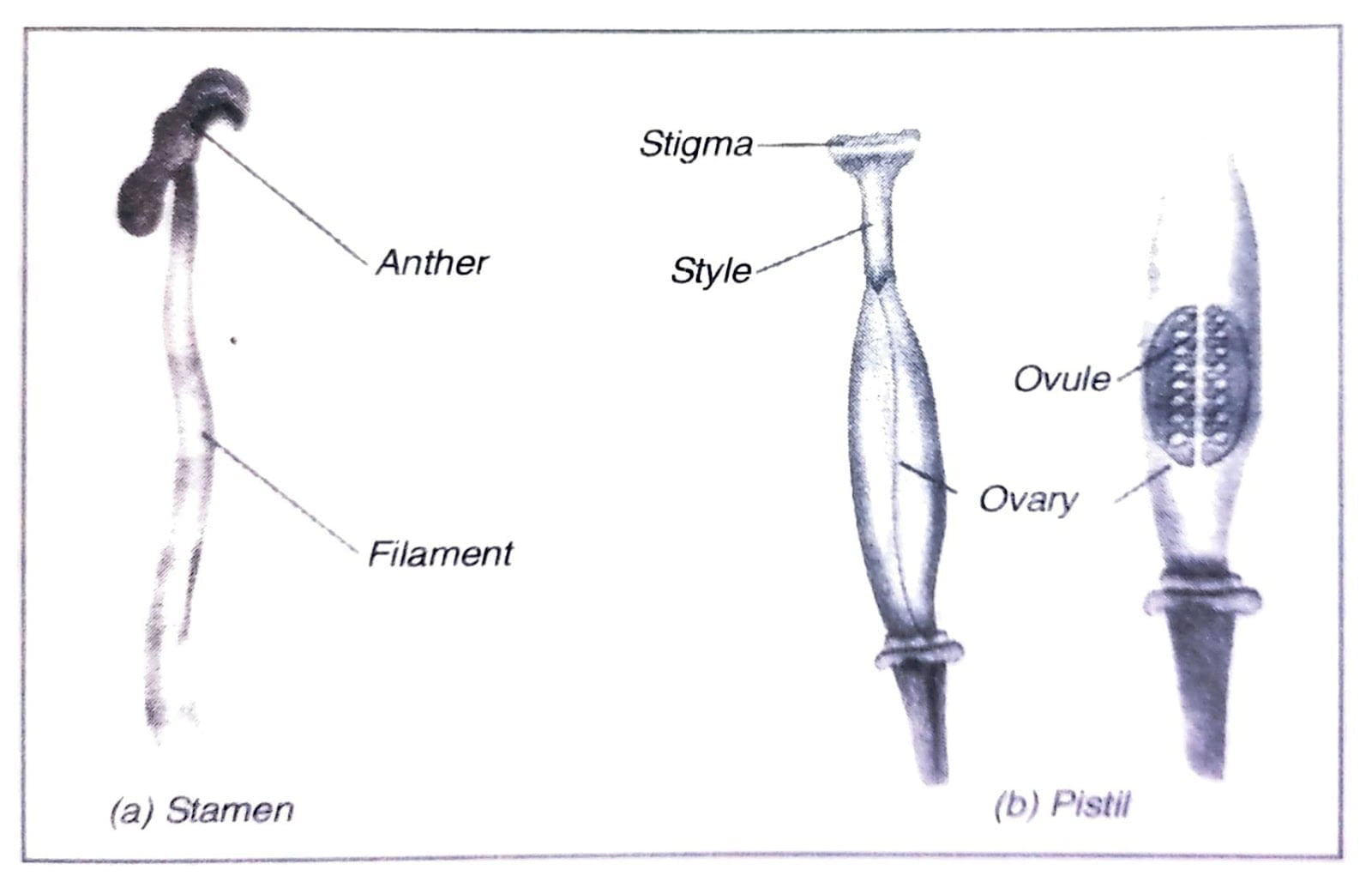
Fig. 5. Reproductive parts of a flower.
Q.6. Explain the difference between self pollination and cross-pollination.
Ans:
| Self-pollination | Cross-pollination |
| (a) Pollen grains are transferred to the stigma of same flower. | (a) Pollen grains are carried to stigma of another flower from one flower. |
| (b) Occurs in bisexual plants having anther and stigma maturing at same time. | (b) Occurs in bisexual flowers having anther and stigma maturing at different times. |
| (c) It takes place in plants like wheat, peas etc. | (c) It takes place in plants like lady’s finger, tomato, brinjal, etc. |
Q. 7. How does the process of ferti- lization take place in flowers?
Ans: When the pollen grain reaches the stigma of a same flower, it starts growing out in pollen tube of the stigma. This tube continues to grow inside the style till it reaches the ovule. Male cells are released in the ovule for the fertilization with female cells and thus the zygote is formed. After this process of fertilization, the ovary develops into fruit and ovule into seeds.
Q. 8. Describe the various ways by which seed are dispersed.
Ans: Following are the ways in which the seeds get dispersed:
(i) Some light seeds like that of Madar, which are hairy, dry and small are carried away by the wind to different places. Some seeds having winged structure eg. that of Maple and Drumstick are also dispersed by air.
(ii) Spiny seeds and fruits like that of Xanthium and Gokhru, the seeds stick to the clothes of passers-bye and animals. These seeds are carried away by these agents to different places.
(iii) In some cases having heavy seeds like that of Coconut, water acts as the dispersing agents.
(iv) Some seeds are dispersed when the fruit bursts like in case of Balsam and castor.
Q. 9. Match the items in Column I with those of Column II:
| Column – I | Column – II |
| (a) Bud | (i) Maple |
| (b) Eyes | (ii) Spirogyra |
| (c) Fragmentation | (iii) Yeast |
| (d) Wings | (iv) Bread mold |
| (e) Spores | (v) Potato |
| (vi) Rose |
Ans:
| Column – I | Column – II |
| (a) Bud | (iii) Yeast |
| (b) Eyes | (v) Potato |
| (c) Fragmentation | (ii) Spirogyra |
| (d) Wings | (i) Maple |
| (e) Spores | (vi) Rose |
Q. 10. Tick (✔) the correct answer:
(a) The reproductive part of a plant is the:
(i) Leaf
(ii) Stem
(iii) Root
(iv) Flower
Ans: (iv) Flower.
(b) The process of fusion of the male and the female gametes is called:
(i) Fertilization
(ii) Pollination
(iii) Reproduction
(iv) Seed formation
Ans: (i) Fertilization.
(c) Mature ovary forms the:
(i) Seed
(ii) Pistil
(iii) Stamen
(iv) Fruit
Ans: (iv) Fruit.
(d) A spore producing plant is:
(i) Rose
(ii) Bread mold
(iii) Potato
(iv) Ginger
Ans: (ii) Bread mold.
(e) Bryophyllum can reproduce by its:
(i) Stem
(ii) Leaves
(iii) Roots
(iv) Flower
Ans: (ii) Leaves.
ADDITIONAL IMPORTANT QUESTIONS
Very Short Answer Type Questions
Q. 1. Define reproduction.
Ans: Reproduction is the production of new individuals of the same species produced by existing organisms.
Q. 2. Define unisexual organisms.
Ans: The organism which bears male and female sex organs in different individuals.
Q. 3. Give one example of animal which reproduce by budding.
Ans: Hydra.
Q. 4. Give two examples in which sexual reproduction occurs by spore formation.
Ans: Rhizopus, Penicillium.
Q. 5. Name the parts of common bread mould (Rhizopus) which contain reproductive units called spores.
Ans: Sporangia.
Q. 6. What is the name of the yellow powdery substance present in the anther of a flower?
Ans: Pollen grains.
Q. 7. What do you mean by vegetative propagation?
Ans: Vegetative propagation is the asexual method of formation of new individuals from the vegetative parts of the plants.
Q. 8. What is grafting?
Ans: Grafting is an artificial vegetative propagation of plants in which a small aerial part (scion) of one plant is joined into the basal part (stock) of another closely related plant species in order to form a composite individual.
Q. 9. What is meant by regeneration?
Ans: It is the growth of a portion of the body which has been injured or lost. It is common in planaria.
Q. 10. Name the following:
(i) Male floral organ.
Ans: Stamen.
(ii) Female floral organ.
Ans: Pistil.
Q. 11. What is a flower?
Ans: Flower is a modified shoot specialized to carry out sexual reproduction.
Q. 12. Define radicle.
Ans: Radicle is an embryonic tip which grows to form the root system of the plant after seed germination.
Q. 13. Define plumule.
Ans: Plumule is the embryonic shoot which develops into the shoot system after germination of seed.
Q. 14. Name the fertilized egg cell formed by the fusion of a male and female gametes.
Ans: Zygote.
Q. 15. Which part of a flower forms the fruit?
Ans: Ovary.
Short Answer Type Questions
Q. 1. Differentiate between binary fission and multiple fission.
Ans: Binary fission is the division of parent cell into two equal sized identical daughter individuals. The multiple fission, on the other hand, is the division of parent cell into several equal sized daughter individuals.
Q. 2. Give two advantages of vegetative propagation.
Ans: (i) It helps in producing identical clones (similar kinds of plants).
(ii) It helps in producing such plants which do not produce viable seeds, or produce very few seeds.
Q. 3. In a bisexual flower inspite of the young stamens being removed artificially, the flower produces fruit. Provide a suitable explanation for the above situation.
Ans: The pistil is intact. Cross-pollination has occurred leading to fertilization and formation of fruit.
Q. 4. Name two animals which reproduce asexually and two which reproduce sexually.
Ans: (i) Amoeba and hydra reproduce by asexual method.
(ii) Cats and dogs reproduce by sexual method.
Q. 5. List any two differences between pollination and fertilization.
Ans:
| Pollination | Fertilization |
| 1. It is the process of transferring of pollen-grains from stamens to the stigma of a carpel. | 1. It is the process of the fusion gamete with the female gamete to form a zygote. |
| 2. Pollination occurs mostly in gymnosperms and angiosperms of plant kingdom. | 2. Fertilization occurs in all living organi- sms where reprod- uction occurs by sexual reproduction. |
Q. 6. Consider the following plants:
Papaya, Mustard, Rose, Corn, Petunia, Cucumber
(a) Which of these plants have unisexual flowers?
Ans: Papaya, Corn, Cucumber.
(b) Which of these plants have bisexual flowers?
Ans: Mustard, Rose, Petunia.
Q. 7. The names of some of the plants are given below:
Xanthium, Castor, Drumstick, Urena, Balsam, Maple, Grass, Madar (Aak), Coconut, Sunflower.
Which of these seeds/fruits are dispersed:
(a) by wind.
Ans: Drumstick, Maple, Grass, Madar (Aak), Sunflower.
(b) by water.
Ans: Coconut.
(c) by animals.
Ans: Xanthium, Urena.
(d) by bursting of fruits?
Ans: Castor, Balsam.
Q.8. Why cannot fertilisation take place in flowers if pollination does not occur?
Ans: In a flower, fertilization requires both male and female gametes. If pollination does not occur, male gamete is not available, hence fertilisation cannot take place.
Q. 9. How will an organism be benefitted if it reproduces through spores.
Ans: An organism will be benefited if it reproduces through spores because under unfavorable conditions the spores are covered by thick walls which protect them.
Under favourable conditions they come into contact with another moist surface and begin to grow.
Q. 10. How do stock and scion combine after grafting?
Ans: In grafting, a scion (a piece of stem of desired plant) is inserted into the stock (the plant that is rooted) in such a way that an organic union (fusion of tissues) occurs.
Moreover, the combial activity of the scion and the stock causes formation of new cells, coming in tied close union. This allows the scion and the stock to unite permanently.
Short Answer Type Questions
Q. 1. Write three differences between binary fission and multiple fission.
Ans:
| Binary fission | Multiple fission |
| 1. The unicellular organism splits into two equal daughter cells by cell division. | 1. Unicellular organisms divide into daughter cells. many |
| 2. Nucleus and cytoplasm divide simultaneously. | 2. First the nucleus divides into many nuclei and then each nuclei is surrounded by cytoplasm and the daughter nuclei are released by rupture of parent cell. |
| 3. Many different patterns of division transverse and longitudinal. Example: Amoeba. | 3. No definite pattern of division. Example: Malaria parasite. |
Q. 2. What are the differences between the plants produced by sexual reproduction and that produced by vegetative reproduction?
Ans: The plants can grow in less time by vegetative propagation. They bear flowers and fruits earlier than those produced by sexual reproduction or from the seeds. The new plants produced by vegetative propagation are exact copies of the parent plant, as they are produced from a single parent, while the plant produced by sexual reproduction is not the true copy of any parent but have the characters of both parents.
Q. 3. Explain how the male gamete in the pollen grains reaches the female gamete present in the ovule.
Ans: When pollen grain falls on the stigma of the pistil, the pollen grain grows a pollen tube downwards through the style towards the female gamete in the ovary. A male gamete moves down the pollen tube. The pollen tube enters the ovule in the ovary. The tip of pollen tube bursts open and male gamete comes out of pollen tube. In ovary, the male gamete of pollen combines with the female gamete present in the ovule to form a fertilized egg cell called zygote.
Q. 4. Consider the following plants:
Yeast, Bryophyllum, Spirogyra, Rose, Fern, Sweet potato.
Which of these plants is produced:
(a) by cuttings?
Ans: Rose.
(b) by leaves?
Ans: Bryophyllum.
(c) by roots?
Ans: Sweet potato.
(d) by spores?
Ans: Fern.
(e) by budding?
Ans: Yeast.
(f) by fragmen- tation?
Ans: Spirogyra.
Q. 5. Why is vegetative propagation practiced for growing some types of plants?
Ans: Vegetative propagation is practiced because:
(i) Some plants do not produce viable seeds or produce very few seeds.
(ii) Characters of the parent plant can be preserved.
(iii) Several plants in a short time can be produced quicky.
Long Answer Type Questions
Q. 1. (a) What are the various parts of the flower?
Ans: Sepals, petals, stamens and pistil.
(b) What are male and female reproductive organs known as in plants?
Ans: In plants, the male reproductive organ is called stamen and female reproductive organ is called pistil.
(c) What are bisexual flowers? Give examples of bisexual plants.
Ans: Bisexual flowers are those which have both the reproductive organs (male as well as female). The plants such as rose, mustard, hibiscus and petunia have bisexual flowers.
(d) What are unisexual flowers? Give examples of unisexual plants.
Ans: The flowers which contain only one reproductive organ (either male or female) are called unisexual flowers. The plants such as papaya, watermelon, corn and cucumber have unisexual flowers.
(e) Name the inner parts of a flower.
Ans: (i) Stamen.
(ii) Pistil.
(iii) Receptacle.
Q. 2. (a) Explain the process of budding.
Ans: In budding, a small part of the body of the parent plant grows out as a bulb-like projection called bud which then detaches and becomes a new plant.
(b) Write the name of organism which reproduce by the process of budding.
Ans: Hydra.
(c) Explain how bedding occurs in Hydra.
Ans: In hydra, a bud develops as an outgrowth due to repeated cell divisions at one specific site. These buds develop into tiny individuals. When fully matures, they detach from the parent body and become new independent individuals.

Fig. 12.36. Bidding in Hydra.
Q. 3. What is meant by tissue culture? How this technique is performed? In which area this technique is finding its application?
Ans: The production of plants by cells or tissues or organs in a synthetic medium is called tissue culture. The synthetic medium used in this technique contains all the nutrients and hormones which are required for the growth.
A cell or tissue is transferred into suitable synthetic medium under sterile conditions. The tissue often develops into a fast growing cellular mass called callus. The callus is transferred to another medium for growth and differentiation that forms plantlets. The plantlets can be transplanted into soil or pots where they can be grown to maturity. Tissue culture technique is being popularly used for production of ornamental plants like orchids, Dahlia and carnation.
HOTS QUESTIONS
Q. 1. If a bread mould plant (Rhizopus fungus), what name is given to:
(a) thread-like projections?
Ans: Hypha.
(b) knob-like structure at the top of thin stem?
Ans: Sporangium.
(c) tiny-reproductive bodies?
Ans: Spores.
Q. 2. The flask-shaped organ X at the center of a flower is surrounded by a number of little stalks Y having swollen tops which lie just inside the ring of petals.
(a) Name the organ X
Ans: Pistil.
(b) Which part of organ X contains gametes ?
Ans: Ovary.
(c) Name the organ Y.
Ans: Stamen.
(d) What does the swollen top of organ Y contain?
Ans: Pollen grains.
(e) Out of X and Y, which one is the female part of flower?
Ans: X.
Q.3. Malarial parasite’ divides into many daughter individuals simultaneously through multiple fission. State one advantage that the parasite gets because of this type of reproduction.
Ans: It produces many individuals through multiple fission which gives better chances of survival for the species. Being a parasite, if few individual gets eliminated then also rest of the individuals multiply rapidly to maintain larger number of parasites.
SKILL BASED QUESTIONS
Q. 1. Draw a diagram to show reproduction in fungus by spore formation. Label the following parts:
(i) Hypha.
(ii) Spores.
(iii) Sporangium. and
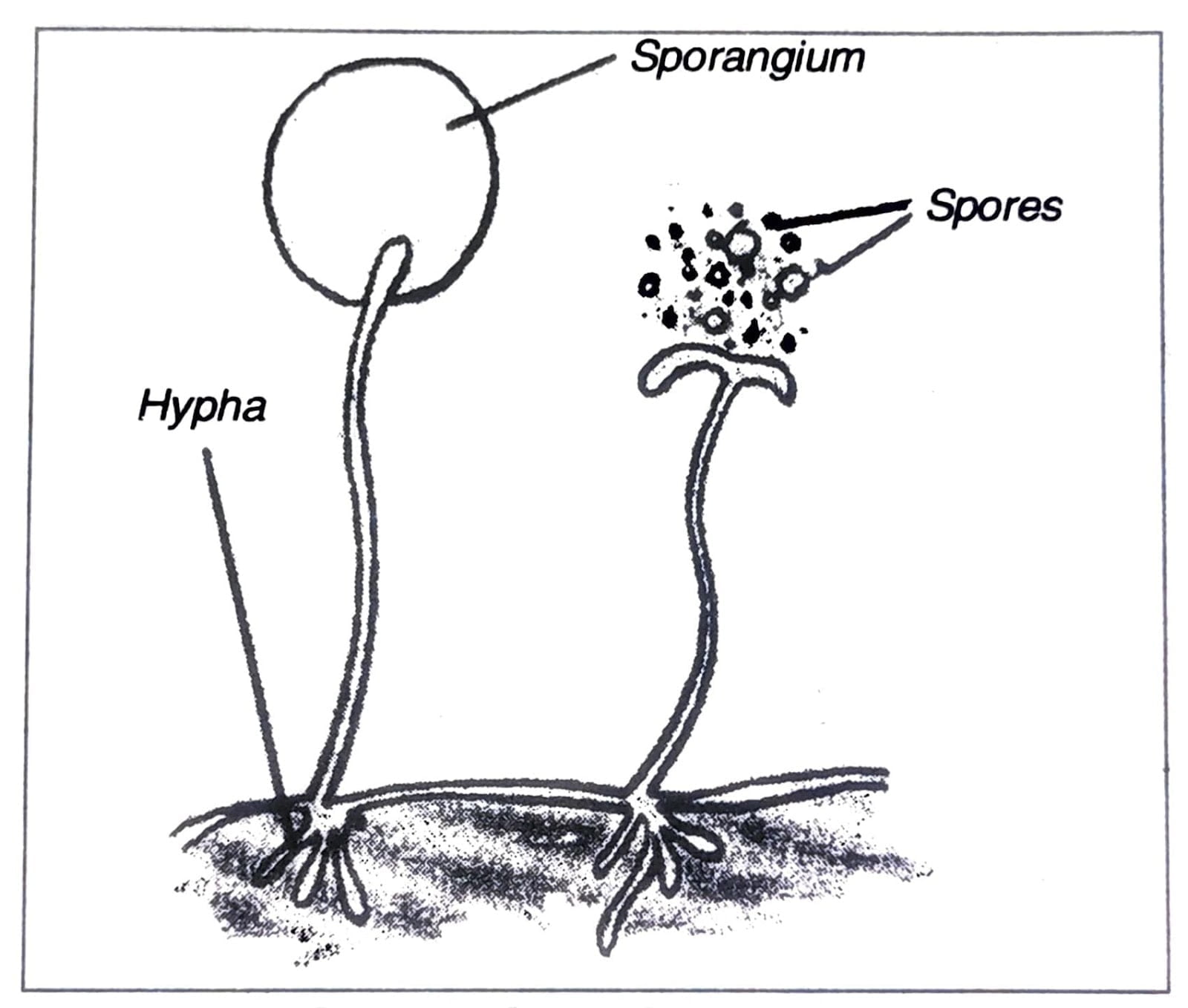
Fig 12.37. Reproduction through spore formation in fungus.
Q. 2. Draw a diagram to show:
(a) Self-pollination.
(b) Cross-pollination.
Ans:
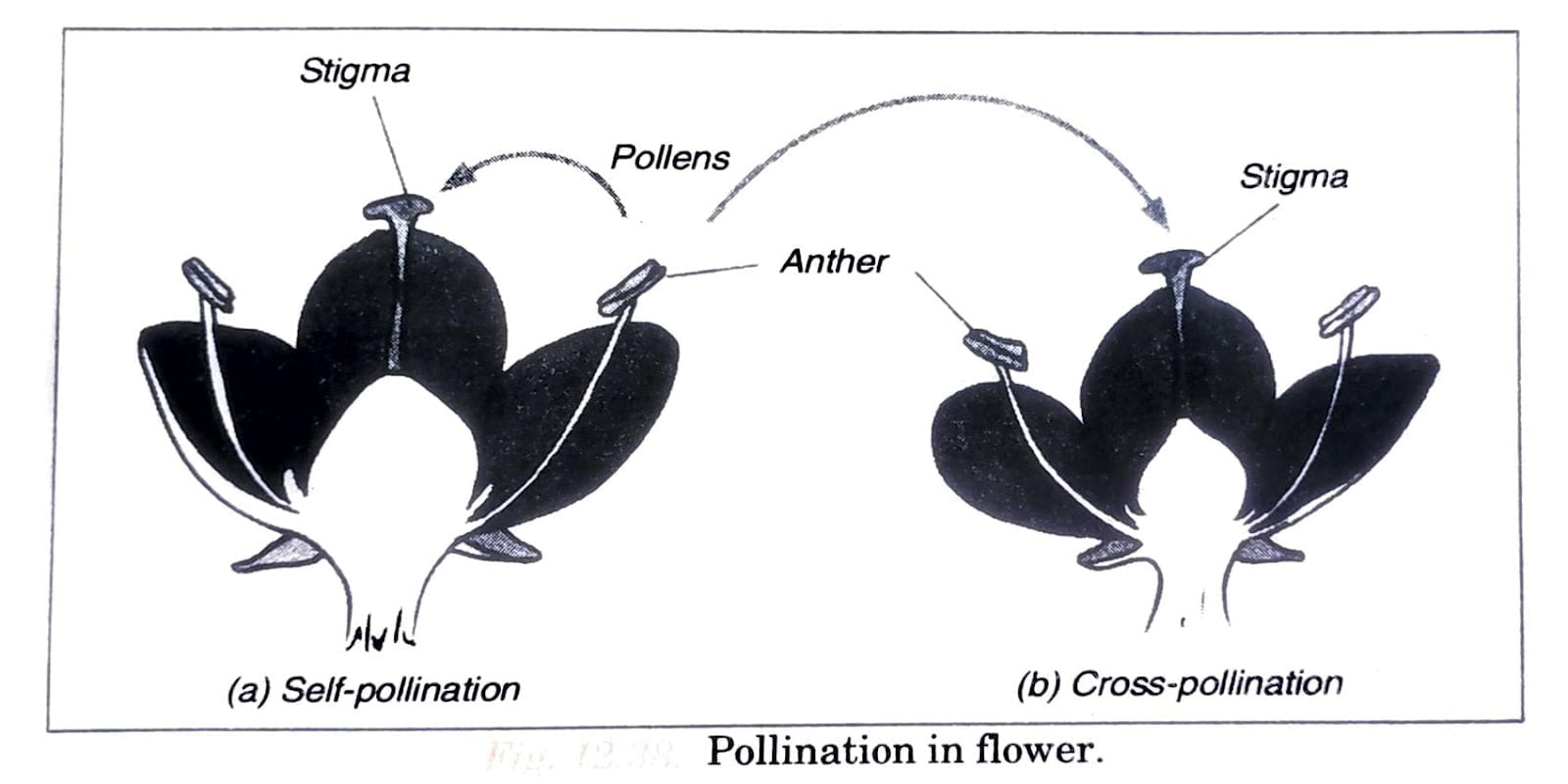
Q. 3. Observe the following figure. Identify it and write how their dispersal takes.
Ans: It is xanthium. Its seeds are spiny with hooks which get attached to the bodies of animals and are carried to distant places.
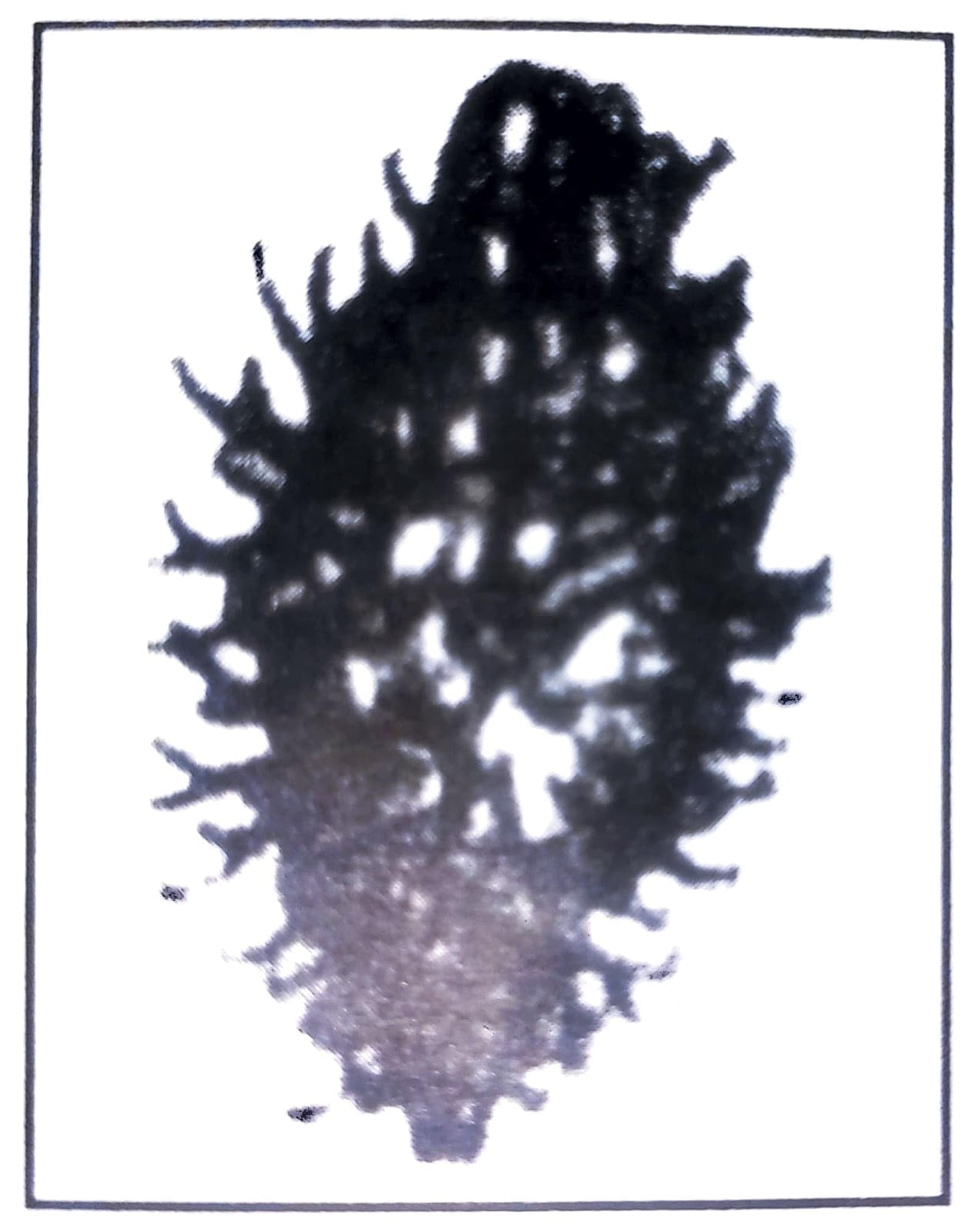
Fig. 12.39. Xanthium
FORMATIVE ASSESSMENT
1. Fill in the following blanks with suitable words:
(i) A flower may have either male or female reproductive parts. Such a flower is called _________ flower.
Ans: Unisexual.
(ii) The transfer of pollen grains from the another to the stigma of the same or another flower of the same kind is known as _________.
Ans: Pollination.
(iii) The fusion of male and female gametes is termed as _________.
Ans: Fertilization.
(iv) Ovules contain _________ gamete pollen grains contain _________ gamete whereas of the plant.
Ans: Female, male.
(v) After fertilization, an ovule becomes a _________ whereas the ovary of a flower becomes a _________.
Ans: Seed, fruit.
(vi) Flower is the _________ part of a plant.
Ans: Reproductive.
(vii) Dandelion seeds are dispersed by _________.
Ans: Wind.
(viii) In sexual reproduction, a male and a female gamete fuse to form a _________.
Ans: Zygote.
2. State whether the following statements are true or false:
(i) The fruits of coconut plants are dispersed by wind.
Ans: False.
(ii) The fruits of Xanthium can be dispersed by sheep.
Ans: True.
(iii) A plant which reproduces by spores is potato.
Ans: False.
(iv) The asexual method of reproduction in yeast is called fragmentation.
Ans: False.
(v) Flowers are always bisexual.
Ans: False.
(vi) All flowers have both male and female parts in the same plant.
Ans: False.
(vii) Coconut is dispersed by water.
Ans: True.
(viii) Reproduction helps in the control of population.
Ans: False.
3. Matching Type Questions Match the statements in Column A with those given in Column B:
| Column – A | Column – B |
| 1. Sugarcane | (a) can be performed at the base of an aerial branch |
| 2. Scion | (b) is possible only in those plants which have vascular cambium |
| 3. Grafting | (c) provides shoot system |
| 4. Air layering | (d) is propagated through stem cuttings |
Ans:
| Column – A | Column – B |
| 1. Sugarcane | (d) is propagated through stem cuttings |
| 2. Scion | (c) provides shoot system |
| 3. Grafting | (b) is possible only in those plants which have vascular cambium |
| 4. Air layering | (a) can be performed at the base of an aerial branch |
4. Write one word for the following:
(i) The process of reproduction in which new plants are obtained from seeds.
Ans: Sexual reproduction.
(ii) Obtaining new plants from the roots, stems and leaves of a plant.
Ans: Vegetative propagation.
(iii) The technique of producing desired variety of plants and fruits from the cutting of the desired plant and the stem of a rooted plant of the same species.
Ans: Grafting.
(iv) Transfer of pollen grains from the anther of a flower to the stigma of the same or some other flower of the same kind.
Ans: Pollination.
(v) The part of a flower consisting of filament and anther.
Ans: Stamen.
(vi) Asexual mode of reproduction in which a small outgrowth (bud) appears on the body of the organism.
Ans: Budding.
(vii) A ball-like structure formed after divisions in the fertilized egg (zygote).
Ans: Embryo.
(viii) Ability of living things to repair themselves or to grow lost parts.
Ans: Regeneration.
5. Multiple Choice Questions:
(i) The method in which the tissues of one plant are encouraged to fuse with those of another is called:
(a) layering
(b) budding
(c) cutting
(d) grafting
Ans: (d) Grafting.
(ii) Asexual reproduction takes place through budding in:
(a) potatoes
(b) ferns
(c) yeast
(d) spirogyra
Ans: (c) Yeast.
(iii) Jasmine is multiplied vegeta tively through:
(a) Stem cutting
(b) leaves
(c) root cutting
(d) layering
Ans: (d) Layering.
(iv) Potato is grown by:
(a) cutting of aerial stems
(b) cutting of tuber having depressions
(e) cutting of tuber without depressions
(d) cutting of roots
Ans: (b) Cutting of tubes having depressions.
(v) The seeds/ fruits of which of the following plant are not dispersed by wind?
(a) drumstick
(b) grass
(c) coconut
(d) cotton
Ans: (c) Coconut.
(vi) Which of the following produces by the method of fragmentation?
(a) potato
(b) bryophyllum
(d) almonds
(c) spirogyra
Ans: (c) Spirogyra.

Hi! my Name is Parimal Roy. I have completed my Bachelor’s degree in Philosophy (B.A.) from Silapathar General College. Currently, I am working as an HR Manager at Dev Library. It is a website that provides study materials for students from Class 3 to 12, including SCERT and NCERT notes. It also offers resources for BA, B.Com, B.Sc, and Computer Science, along with postgraduate notes. Besides study materials, the website has novels, eBooks, health and finance articles, biographies, quotes, and more.



